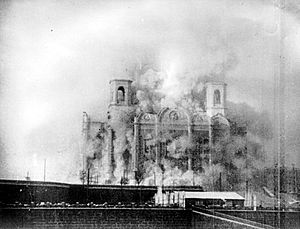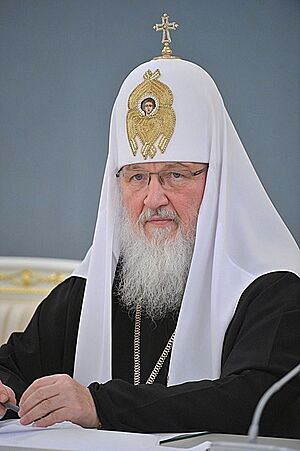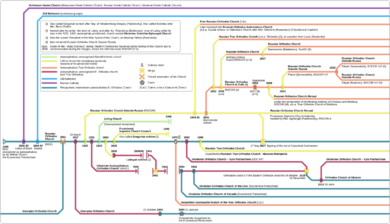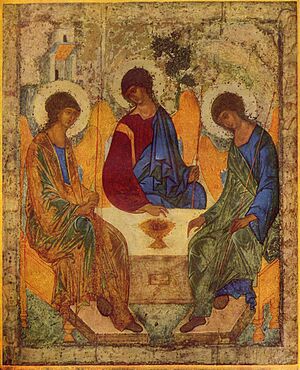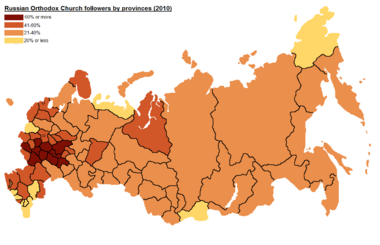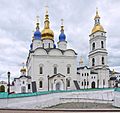Russian Orthodox Church facts for kids
Quick facts for kids Russian Orthodox Church (Moscow Patriarchate) |
|
|---|---|
| Русская православная церковь | |
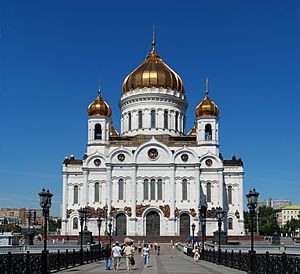
|
|
| Abbreviation | ROC |
| Classification | Eastern Orthodox |
| Orientation | Russian Orthodoxy |
| Scripture | Elizabeth Bible (Church Slavonic) Synodal Bible (Russian) |
| Theology | Eastern Orthodox theology |
| Polity | Episcopal |
| Governance | Holy Synod of the Russian Orthodox Church |
| Structure | Communion |
| Primate | Patriarch Kirill of Moscow |
| Bishops | 382 (2019) |
| Clergy | 40,514 full-time clerics, including 35,677 presbyters and 4,837 deacons |
| Parishes | 38,649 (2019) |
| Dioceses | 314 (2019) |
| Monasteries | 972 (474 male and 498 female) (2019) |
| Associations | World Council of Churches |
| Region | Russia, post-Soviet states, Russian diaspora |
| Language | Church Slavonic, Russian |
| Liturgy | Byzantine Rite |
| Headquarters | Danilov Monastery, Moscow, Russia 55°42′40″N 37°37′45″E / 55.71111°N 37.62917°E |
| Founder | Saint Vladimir the Great |
| Origin | 988 Kievan Rus' |
| Independence | 1448, de facto |
| Recognition |
|
| Separations |
|
| Members | 110 million (95 million in Russia, total of 15 million in the linked autonomous churches) |
| Other name(s) |
|
The Russian Orthodox Church (ROC; Russian: Русская православная церковь, romanized: Russkaya pravoslavnaya tserkov') is a major Eastern Orthodox Christian church. It is also known as the Moscow Patriarchate. It has 194 church regions, called dioceses, within Russia. The main leader of the ROC is the Patriarch of Moscow and all Rus'.
The Christian faith began to spread in Kievan Rus' in 988. This happened when Vladimir the Great, the Grand Prince of Kiev, and his people were baptized. This event was led by clergy from the Ecumenical Patriarch of Constantinople. The leader of the Russian Church, called the Metropolitan of Kiev and all Rus', was under the Ecumenical Patriarchate until 1686.
Today, the Russian Orthodox Church believes it has special authority over Eastern Orthodox Christians. This includes people in countries that were once part of the Soviet Union, except for Georgia. The ROC also helped create the Orthodox Church in Japan and Chinese Orthodox Church, which are churches that manage themselves.
There is also another church called the Russian Orthodox Church Outside of Russia (ROCOR). It started in the 1920s by Russian groups outside the Soviet Union. They did not recognize the Moscow Patriarchate's authority at that time. However, the two churches came back together on May 17, 2007. Now, the ROCOR is a self-governing part of the Russian Orthodox Church.
Contents
- History of the Russian Orthodox Church
- Structure and Organization
- Worship and Practices
- Church Connections and Members
- Images for kids
- See also
History of the Russian Orthodox Church
Early Beginnings in Kievan Rus'
The Christian community that became the Russian Orthodox Church has a long history. It is traditionally believed that Apostle Andrew visited the areas of Scythia and the northern Black Sea coast. Legend says Andrew reached the future site of Kiev and predicted a great Christian city would be built there. A cross he reportedly put up is now marked by St. Andrew's Cathedral.
Moving the Church Center to Moscow
As Kiev became less important, the church leader, Metropolitan Maximus, moved to Vladimir in 1299. His successor, Metropolitan Peter, then moved the church's main home to Moscow in 1325.
In 1439, at the Council of Florence, some Orthodox leaders agreed to unite with the Roman Church. This meant they would accept the Pope as their leader. However, the Moscow Prince Vasili II rejected this agreement in 1441. The Russian metropolitan was then without a leader for several years.
In 1448, a Russian bishop named Jonas was chosen as Metropolitan of Kiev and All Russia. This happened without the approval of Constantinople. This event, before the fall of Constantinople in 1453, marked the start of the Moscow church becoming independent. Later, people in Moscow began to see their city as the "Third Rome." They believed it was the true successor to Constantinople.
Church Changes Under Peter the Great
Peter the Great (1682–1725) wanted to make Russia more like Western Europe. He aimed to improve the government, army, and even people's clothing and manners. Peter was not very religious and wanted to control the Church tightly.
In 1721, he replaced the Patriarch (the church's leader) with a group called the Holy Synod. The Tsar controlled this Synod and appointed all bishops. This meant the church was under strong government control. This system lasted until after the Russian Revolution in 1917.
Church Expansion and Influence
After the Treaty of Pereyaslav, the Ottomans influenced the Patriarch of Constantinople. This led to the Metropolitan of Kiev and all Rus' moving from Constantinople's control to Moscow's. This change brought many Ukrainian believers and dioceses under the Moscow Patriarchate. This led to a strong Ukrainian presence in the Russian Church for a long time.
In the late 18th century, a spiritual movement called starchestvo grew. This brought a spiritual revival to the Russian Church. Important thinkers like Aleksey Khomyakov developed new ideas about Orthodox beliefs. This renewed interest in faith was even seen in Russian books, like Fyodor Dostoyevsky's Brothers Karamazov.
The Russian Revolution and Civil War
The year 1917 was a huge turning point for Russia and its church. In March 1917, the Tsar was forced to step down. The government's direct control over the Church ended by August 1917.
On August 15, 1917, the Local Council of the ROC began in Moscow. This was the first such meeting since the late 17th century. The council decided to bring back the Patriarchate. Three days after the Bolsheviks took power, Tikhon was chosen as the first Russian Patriarch in about 200 years.
In February 1918, the new Soviet government declared that church and state were separate. This meant religious groups could not own property and had no legal status. Religious activities were mostly limited to services inside church buildings. The church leaders saw these actions as an attack. Patriarch Tikhon spoke out against those who harmed the church.
The church was caught in the middle of the Russian Civil War. Even though church leaders tried to stay neutral, Soviet authorities saw them as against the revolution. Many clergy and believers faced harsh treatment. In the first five years after the revolution, many bishops and priests were executed.
Under Soviet Rule
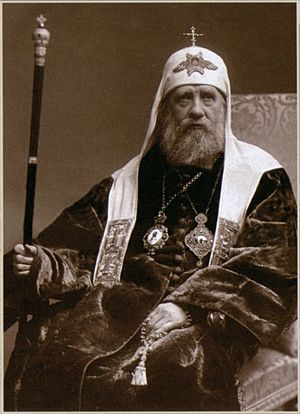
The Soviet Union, formed in 1922, was the first state to aim at getting rid of religion. The government took church property, made fun of religion, and taught atheism in schools. However, they did not outlaw most organized religions.
Orthodox clergy and active believers were often seen as enemies of the revolution. They faced arrests, exile, and imprisonment in labor camps. Sometimes they were even sent to mental hospitals.
However, the Soviet government's approach to religion changed over time. They sometimes tried to completely remove religion, but other times they accepted that faith was strong. Religious beliefs continued, not just at home but also in some public places. The state realized it could not fully get rid of religion.
The Russian Orthodox Church became weaker in May 1922. A reform movement called the Living Church, supported by the Soviet secret police, broke away from Patriarch Tikhon. This caused divisions among church members that lasted until 1946.
Between 1917 and 1935, many Eastern Orthodox priests were arrested. Many thousands of people who suffered during this time are now recognized as "new martyrs and confessors of Russia."
When Patriarch Tikhon died in 1925, the Soviet authorities did not allow a new Patriarch to be chosen. The acting Patriarch, Metropolitan Sergius, made a statement in 1927. He accepted Soviet authority over the church and promised cooperation. This caused a split with the Russian Orthodox Church Outside of Russia and the Russian True Orthodox Church. These groups felt Sergius had gone against church rules.
After Nazi Germany attacked the Soviet Union in 1941, Joseph Stalin allowed the Russian Orthodox Church to become more active. This was to encourage people to support the war effort. In September 1943, Metropolitans Sergius, Alexius, and Nicholas (Yarushevich) met with Stalin. They received permission to hold a council, which elected Sergius as Patriarch. New theological schools were opened, and many churches began to operate again.
Persecution Under Khrushchev
A new period of persecution began under leaders like Nikita Khrushchev. Between 1959 and 1964, many churches were closed. The number of Orthodox churches dropped sharply. Priests, monks, and believers were killed or imprisoned.
After Khrushchev, the Church and government still had a difficult relationship until 1988. People who were openly religious could not join the Communist Party of the Soviet Union. This meant they could not hold political jobs. However, many ordinary people remained religious.
Some Orthodox believers and priests spoke out against the government. They became prisoners of conscience. Priests like Gleb Yakunin spent years in prison for defending religious freedom.
By 1988, the number of active churches in the Soviet Union had fallen to 6,893. The number of active monasteries was only 21. Still, many babies were baptized, and many deceased received Christian funerals.
Glasnost and Church-State Relations
Starting in the late 1980s, under Mikhail Gorbachev, new freedoms emerged. Many church buildings were returned to the church and restored. A key moment was in 1988, the 1000-year anniversary of the Christianization of Kievan Rus'. Big celebrations took place, and many old churches and monasteries reopened. For the first time, church services were shown live on state television.
Some critics argued that the Moscow Patriarchate worked closely with the KGB (the Soviet secret police). They claimed that top church leaders helped the KGB in its work. However, church leaders like Patriarch Alexy II admitted that they had to make compromises with the Soviet government to protect their people and survive. He publicly expressed regret for these compromises.
The Church After the Soviet Union
Patriarch Aleksey II (1990–2008)
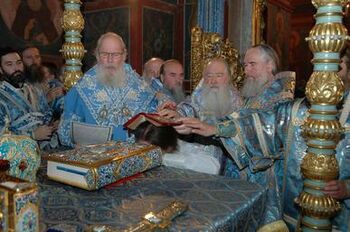
Metropolitan Alexy (Ridiger) became Patriarch in 1990. He led the church through a period of recovery after 70 years of repression. By the end of his time as Patriarch, about 15,000 churches had been reopened or built. This rebuilding continued under his successor, Patriarch Kirill. In 2016, the Church had many dioceses, bishops, parishes, monasteries, and theological schools.
The Russian Church also tried to fill the gap left by the end of Communism. Some people even saw it as a "separate branch of power."
Under Patriarch Alexy, there were some difficulties with the Vatican. This was especially true after 2002, when Pope John Paul II created Catholic church structures in Russia. The Russian Church saw this as an attempt to convert Russian Orthodox believers to Catholicism.
There were also conflicts with the Ecumenical Patriarchate, especially over the Orthodox Church in Estonia in the mid-1990s. This led to a temporary break in relations between the churches.
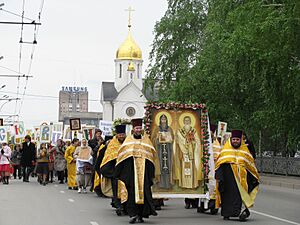
Some observers noted that the Moscow Patriarchate acted like a state church. They said that Orthodox clergy who disagreed with the close ties between church and state faced strong criticism. Clifford J. Levy of The New York Times wrote in 2008 that the government had made the Russian Orthodox Church a "de facto official religion." This close link between the government and the church became a key feature of Vladimir Putin's time in power.
Patriarch Kirill (Since 2009)
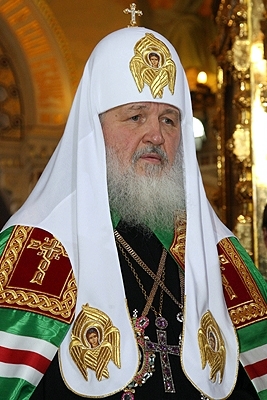
On January 27, 2009, Metropolitan Kirill of Smolensk was elected Patriarch of Moscow and All Rus′. He officially took office on February 1, 2009.
Patriarch Kirill made changes to the church's structure. In 2011, the Holy Synod created the Central Asian Metropolitan District. This reorganized the church in countries like Tajikistan and Uzbekistan. Also, new administrative units called "metropolies" were introduced.
Under Patriarch Kirill, the ROC continued its close relationship with the Kremlin. President Vladimir Putin has supported Russian Orthodoxy both inside and outside Russia. Patriarch Kirill supported Putin's election in 2012, calling his time in office "God's miracle."
Disagreements with Constantinople
In 2018, the Moscow Patriarchate had a disagreement with the Patriarchate of Constantinople. This was partly due to Moscow's anger over the decision to grant independence to the Ukrainian church. The ROC decided to boycott a major meeting of all Orthodox Churches.
On October 15, 2018, the Holy Synod of the ROC ended its full connection with the Ecumenical Patriarchate of Constantinople. This decision came after Constantinople effectively ended Moscow's authority over Ukraine. Constantinople also promised independence to the Ukrainian church, despite strong opposition from the ROC and the Russian government.
While the Ecumenical Patriarchate established the Orthodox Church of Ukraine in January 2019, the ROC continued to claim its own branch in Ukraine was the only true Orthodox church there.
In October 2019, the ROC also broke ties with the Church of Greece. This happened after Greece recognized the Ukrainian church's independence. The ROC also stopped allowing its followers to visit certain church regions in Greece.
On November 8, 2019, the Russian Orthodox Church announced it would stop recognizing the Patriarch of Alexandria and all Africa. This was because his Church also recognized the Ukrainian church.
On September 27, 2021, the ROC created a special day of remembrance for all Eastern Orthodox Christians who suffered under the Soviet government. This day is October 30.
Russian Invasion of Ukraine

Metropolitan Onufriy of Kyiv, the leader of the Ukrainian Orthodox Church (Moscow Patriarchate) (UOC-MP), called the conflict "a disaster." He said that the Ukrainian and Russian peoples came from the same Christian roots. He asked for an immediate end to the conflict. After the conflict began, many UOC-MP churches considered joining the Orthodox Church of Ukraine. The stance of Patriarch Kirill of Moscow was often cited as a reason.
Some Russian Orthodox priests have spoken out against the conflict. Some have faced consequences for their anti-conflict sermons. In Kazakhstan, a Russian Orthodox priest who signed a letter condemning the conflict was forced to resign.
Patriarch Kirill has referred to the conflict as "current events" and has avoided using terms like war. He has supported the actions of Russian soldiers. The Moscow Patriarchate sees Ukraine as part of its traditional church territory.
In March 2022, Kirill participated in a video call with Pope Francis. Pope Francis later said that Kirill read from a paper justifying the conflict. Representatives of the Vatican have criticized Kirill for not seeking peace.
The Russian Orthodox St Nicholas church in Amsterdam, Netherlands, decided to leave the Moscow Patriarchate. They requested to join the Ecumenical Patriarchate of Constantinople. The Russian Orthodox Church in Lithuania also stated they did not share Kirill's political views and sought independence.
In April 2022, 200 priests from the Ukrainian Orthodox Church (Moscow Patriarchate) asked other Orthodox church leaders to hold a council. They wanted Kirill to be judged for his statements about the conflict. They said they could not remain under Moscow's authority.
When the Ukrainian Orthodox Church (Moscow Patriarchate) declared its independence from the Moscow Patriarchate on May 27, 2022, Kirill said that "evil spirits" wanted to separate the Russian and Ukrainian peoples.
Cardinal Kurt Koch, a Vatican official, called the Patriarch's justification of the conflict "a heresy." Kirill supported the call for citizens to join the military. He said that those who give their lives for their country will be with God.
In 2023, North Macedonia and Bulgaria expelled senior members of the Russian Orthodox Church. This raised questions about the church's role in spreading political messages. Patriarch Bartholomew criticized the Russian church. He said it was teaching a "theology of war" to justify an "unjust, unholy, unprovoked, diabolical war."
In March 2024, a document approved by the World Russian People's Council, led by Kirill, called the conflict a "Holy War." It stated the war aimed to protect the world from "globalism" and the "victory of the West, which has fallen into Satanism." The document also claimed that all of Ukraine should be under Russia's influence. It said that Belarusians and Ukrainians should be seen as subgroups of Russians.
Structure and Organization
The Russian Orthodox Church has a clear structure. Its parts in countries outside Russia are registered as separate legal groups.
The church is organized in levels. The smallest unit is a parish, which is usually a single church building and its members. A priest leads the parish. All parishes in a region belong to an eparchy, which is like a Western diocese. Bishops lead eparchies. There are 261 Russian Orthodox eparchies around the world.
Some eparchies are grouped into exarchates, like the Belarusian exarchate. Since 2003, they can also be grouped into metropolitan districts, such as the ROC eparchies in Kazakhstan and Central Asia.
Since the early 1990s, ROC eparchies in some new independent countries have special self-governing status. These include the Estonian, Latvian, Moldovan, and Ukrainian Orthodox Church (Moscow Patriarchate) (UOC-MP) churches. The UOC-MP is almost fully independent in its daily operations.
The Russian Orthodox Church Outside of Russia (ROCOR) also has a self-governing status since 2007. The Chinese Orthodox Church and the Japanese Orthodox Churches have full self-rule from Moscow. However, not everyone recognizes this.
Smaller eparchies are led by one bishop. Larger ones, exarchates, and self-governing churches are led by a Metropolitan archbishop. They may also have other bishops.
The highest authority in the ROC is the Local Council. This council includes all bishops, clergy, and regular church members. Between councils, the Holy Synod of the Russian Orthodox Church handles the main administration. The Patriarch of Moscow and All Russia leads the Holy Synod.
The Patriarch of Moscow has a lot of power in running the church. However, unlike the Pope, he does not have direct authority over churches outside the Urban Diocese of Moscow. He also does not have sole power over matters of faith or issues affecting all Orthodox Christians.
Orthodox Church in America (OCA)

The OCA started with Russian Orthodox monks in Alaska in 1794. Alaska was then part of Russian America. After the United States bought Alaska in 1867, this grew into a full diocese of the Russian Orthodox Church. By the late 1800s, the Russian Orthodox Church grew in other parts of the United States. This was due to immigrants from Eastern and Central Europe and the Middle East. These immigrants, no matter their background, were part of one North American diocese of the Russian Orthodox Church.
During World War II, the Moscow Patriarchate tried to regain control of these groups abroad. After reconnecting with Moscow in the early 1960s, the Metropolia became the Orthodox Church in America (OCA) in 1970. It was granted self-rule, but this status is not recognized by all Orthodox churches. However, the Ecumenical Patriarch of Constantinople and other churches remain in connection with the OCA. The Moscow Patriarchate gave up its claims in the United States and Canada. It also recognized the self-governing church in Japan in 1970.
Russian Orthodox Church Outside Russia (ROCOR)
The Russian Church faced great challenges after the October Revolution. Many Russians fled to the United States, Canada, and Europe. The Revolution cut off large parts of the Russian church from regular contact with the main church.
On December 28, 2006, it was announced that the ROC and ROCOR would sign an agreement to reunite. The signing happened on May 17, 2007. This fully restored their connection. They celebrated with a special church service at the Cathedral of Christ the Saviour in Moscow.
Under this agreement, ROCOR remains a self-governing part of the Russian Church. It manages its own administrative, pastoral, and property matters. Its leaders and bishops are chosen by its own Council and confirmed by the Patriarch of Moscow. ROCOR bishops also take part in the Council of Bishops of the entire Russian Church.
Some groups opposed this reunion and broke away from ROCOR. Today, both the OCA and ROCOR are in connection with the ROC.
Self-Governing Branches of the ROC
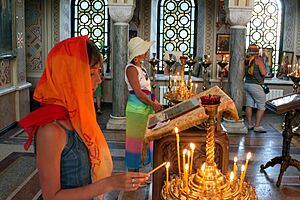
The Russian Orthodox Church has several levels of self-government. The churches that manage themselves within the ROC are:
- The Ukrainian Orthodox Church (Moscow Patriarchate), which has a special status almost like full independence.
- Self-governed churches in Estonia, Latvia, Moldova, and the Russian Orthodox Church Outside of Russia.
- Belarusian Orthodox Church, which is an exarchate. There are also Patriarchal Exarchates in South-East Asia, Western Europe, and Africa.
- The Pakistan Orthodox Church.
- The Metropolitan District of Kazakhstan.
- The Japanese Orthodox Church.
- The Chinese Orthodox Church.
- The Archdiocese of Russian Orthodox churches in Western Europe.
Even though the Ukrainian Orthodox Church (Moscow Patriarchate) says it has removed all links to Moscow, the Russian Orthodox Church still includes its clergy in various groups. This happens even if the Ukrainian clergy do not agree to it.
Worship and Practices
How Saints are Recognized (Canonization)
In the Orthodox Church, a person of faith can first be recognized as a saint at a local level. This happens within local churches and regions, with the Patriarch's blessing. Local believers record miracles, write about the saint's life, create an icon, and compose prayers. All this information is sent to a special church committee for approval. If approved, the local leader performs the act of recognizing the saint.
These saints are not yet recognized by the entire Church. When a saint's fame grows beyond their local area, the Patriarch and Holy Synod decide if they should be recognized by the whole Church. After their support, the question goes to the Local Council of the Russian Orthodox Church.
After the revolution and during the communist persecutions, no new saints were recognized until 1970. In 1970, the Holy Synod recognized Nicholas Kasatkin, a missionary to Japan. In 1977, St. Innocent of Moscow was also recognized. In the 1980s, the Russian Orthodox Church restarted the process of recognizing saints.
In 1989, the Holy Synod created a special committee for recognizing saints. The 1990 Local Council of the Russian Orthodox Church asked this committee to prepare documents for new martyrs. These were people who suffered during the 20th-century Communist persecutions. In 1991, it was decided that each church region would have a local committee to gather information.
In 1992, the Church set January 25 as a day to honor the new 20th-century martyrs. This day was chosen because Metropolitan Vladimir of Kiev was killed on this day in 1918. He was the first church leader to die during the communist terror.
During the 2000 Council of the Russian Orthodox Church, the largest recognition of saints in Orthodox history took place. Many saints were recognized by name, and others were recognized as "known to God."
Icon Painting
The use and creation of icons came to Kievan Rus' after it became Orthodox Christian in 988 AD. These icons usually followed the styles and rules from Byzantine art, which came from Constantinople. Over time, Russians developed their own unique styles and types of icons.
Russian icons are usually paintings on wood. They are often small, but some in churches and monasteries can be very large. Many religious homes in Russia have icons hanging in a special "beautiful corner." Icons have a rich history and deep religious meaning.
In Russian churches, the main part of the church is separated from the altar area by an iconostasis. This is a wall covered with icons, with double doors in the middle. Russians sometimes say an icon is "written" because the same word in Russian means both to paint and to write. Icons are seen as the Gospel in paint. Great care is taken to make sure they show the Gospel faithfully. Icons believed to be miraculous were said to "appear."
Bell Ringing
Bell ringing is an important tradition in the Russian Orthodox Church. It has a history dating back to the time when Christianity first came to Rus'.
Church Connections and Members
Ecumenism and Interfaith Relations
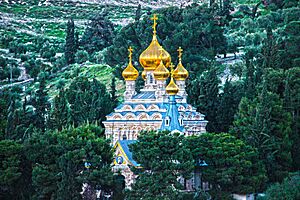
In May 2011, Hilarion Alfeyev, a leader in the Russian Orthodox Church, said that Orthodox and Evangelical Christians agree on many things. He mentioned "family and marriage" as examples. He wanted more cooperation between the two Christian groups.
Hilarion Alfeyev also believes that Islam and Christianity can live peacefully together in Russia. He said the two religions have never fought religious wars there. He stated that the Russian Orthodox Church strongly disagrees with atheist secularism. He believes it harms something very important about human life.
Today, the Russian Orthodox Church has church missions in Jerusalem and other countries around the world.
Membership Numbers
The Russian Orthodox Church is often said to be the largest of all Eastern Orthodox churches. Including all the self-governing churches under its care, it has over 112 million followers worldwide. This is about half of all Eastern Orthodox Christians. Among all Christian churches, the Russian Orthodox Church is second only to the Roman Catholic Church in terms of followers.
In Russia, a 2007 poll showed that about 75% of the population considered themselves Orthodox Christian. Many ethnic Russians and Russian-speakers from other groups identify as "Orthodox." A similar number of Belarusians and Ukrainians also identify as "Orthodox." However, a 2012 poll suggested that only 41% of Russians identified with the Russian Orthodox Church. Another poll in 2012 showed 74% of Russians considered themselves Orthodox. A 2017 survey found that 71% of Russians said they were Orthodox Christian. In 2021, a Russian poll estimated that 66% of Russians were Orthodox Christians.
Images for kids
-
Russian Orthodox monks defended the Trinity monastery against Polish troops during the Time of Troubles. Painting by Sergey Miloradovich.
-
St. Sophia-Assumption Cathedral in Tobolsk
-
Russian Orthodox church in Dresden, built in the 1870s
-
Opening of monument to the victims of political repressions, Moscow, 1990
-
Cathedral of the Annunciation in Pavlodar, Kazakhstan
See also
 In Spanish: Iglesia ortodoxa rusa para niños
In Spanish: Iglesia ortodoxa rusa para niños
- Eparchies and Metropolitanates of the Russian Orthodox Church
- List of Slavic studies journals
- Russian Church property restitution


